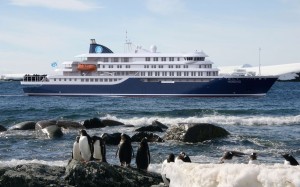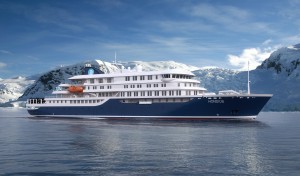
Due to an increased demand for polar cruises, Oceanwide Expeditions, the leading exploratory Polar cruise company since 1996, has commissioned the building of an innovative 180-passenger vessel. The ship, called the Hondius, will be the strongest ice-strengthened vessel in the Polar regions. It is being built in Croatia by shipbuilder Brodosplit and will be available to customers in 2019.
“We currently sail with our ice-strengthened 116-passenger vessels Plancius and Ortelius, and the Hondius will give us the opportunity to accommodate more travelers, to grow as a company, and to offer new, innovative products in the Polar regions,” says Oceanwide Expeditions’ CEO, Michel van Gessel. “The name Hondius follows our custom to name our ships for celebrated Dutch-Flemish cartographers who continue to inspire us as we carry on their passion for exploration and discovery.”
Hondius was specially designed to support and serve Oceanwide’s exploratory programs and activity-based shore excursions in the Arctic and Antarctica. It will be rated Polar Class 6, similar to the previous Finnish-Swedish ice-class notation 1A-super. A speedy zodiac embarkation is guaranteed, with two separate gangways and an indoor platform that can be used for outdoor activities such as kayaking. While Hondius is at anchor during passenger excursions, it can drift or remain in position with the support of the bow and stern thrusters. One deck on board is reserved for an observation lounge, with a separate lecture room in order to offer simultaneous or multilingual lectures and presentations.
The vessel size will be 107 meters (350 feet) long, with a breadth of 17.6 meters (58 feet). It will be equipped with two main engines for a total of 4,200 kW, generating a speed of 15 knots.
Hondius will offer passengers an advanced hotel standard of quarters, as well as a variety of cabin categories, from spacious suites and superiors to twin and quadruple cabins. Guests will be accommodated in the following configurations: 1 spacious suite (cabin size 33 m2), 6 suites with balcony (cabin size: 29 m2), 8 superior cabins with balcony (cabin size: 22 m2), 19 twin deluxe cabins, (cabin size: 22 m2), 14 twin-window cabins (cabin sizes: 14 to 16 m2), 31 twin porthole cabins, 2 triple porthole cabins and 4 quadruple porthole cabins (cabin sizes of the porthole cabins vary from 13 to 16 m2).

“While traveling with Hondius, our passengers will recognize our distinctive Oceanwide approach -- a pleasant, informal atmosphere onboard, with a main focus on in-depth nature and wildlife programs and related shore activities,” said Van Gessel.
Over the years, Oceanwide Expeditions has developed a variety of outdoor activities and offers a dedicated Basecamp program that highlights free activities such as camping, kayaking, shore excursions including snowshoeing, mountaineering, zodiac cruises, scuba diving, and a photography workshop.
Opportunities for innovation and quality
Hondius gives Oceanwide Expeditions new opportunities to offer innovative and quality experiences. Oceanwide, a winner of a World Travel Award for Leading Polar Expedition Operator, is known for constant product innovation. Recent examples include shore-based excursion programs and special exploratory voyages, ship-based helicopter trips to the Ross Sea and the Emperor Penguins in the Weddell Sea, ski and sail programs in Spitsbergen and Greenland, and expeditions to the world’s most remote locations, such as Peter I Island and Bouvet Island.
Reducing negative impact on the environment
Hondius will be built according to the latest requirements of the International Maritime Organization, in particular concerning the safety of life at sea (SOLAS) and the prevention of pollution from ships (MARPOL) for passenger vessels.
The propulsion system consists of two medium speed main engines and one adjustable pitch propeller. The flexible power management (in combination with a shaft generator instead of a diesel-driven generator) permits the lowest possible fuel consumption and CO2 emission, and therefore a minimum possible impact on the environment. Further environmental features include the use of biodegradable lubrication oils; certifiably hazardous-free coating and paint of the vessel; the use of steam for onboard heating; minimal use of electrical heating (for less fuel consumption); LED interior and exterior lighting (reducing power and fuel needs); and waste heat, such as cooling water for the main engines, reused for the production of fresh water. All further existing requirements and restrictions while at sea and in the Polar regions will be strictly followed.
